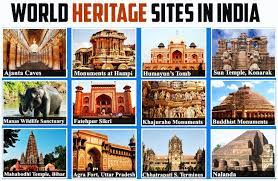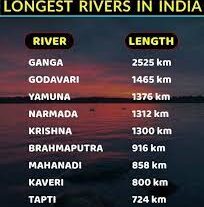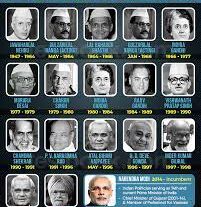A UNESCO World Heritage Site can be any place such as a forest, lake, building, island, mountain, monument, desert, complex or a city that has a special physical or cultural significance. India has a new addition this year to this list- The Durga Puja of Kolkata.
1.Agra Fort: Agra Fort, also known as “Agra Quila”, is located in Agra, India. It is tagged as world heritage site by UNESCO in 1983. The fort is about 2.5 kilometers far from the Taj Mahal. It was designed and built by the great Mughal Emperor Akbar in the year 1565 A.D . Agra was the capital of India in the ancient times. This glorious fort is built alongside Yamuna River. The 380,000 m2 (94-acre) fort has a semicircular plan. It has four gates; two of the fort’s gates are notable: the “Delhi Gate” and the “Lahore Gate.”
2.Ajanta caves: The Ajanta Caves in Aurangabad district of Maharashtra state of India are about 30 rock-cut Buddhist cave monuments which constructed from the 2nd century BCE to about 480 or 650 CE. These paintings are magnum opus of Buddhist religious art, with figures of the Buddha and depictions of the Jataka tales (stories related to the life Lord Buddha). The Ajanta Caves have been a UNESCO World Heritage Site in 1983.
3.Ellora Caves: Ellora is an archaeological site 29 km (18 mi) north-west of the city of Aurangabad in the Indian state of Maharashtra, built by Kalachuri, Chalukya and Rashtrakuta dynasties during (6th and 9th centuries). The 34 “caves” are actually structures excavated out of the vertical face of the Charanandri hills. These caves are dedicated to Hindu, Buddhist and Jain religions. The 17 Hindu (caves 13–29), 12 Buddhist (caves 1–12) and 5 Jain (caves 30–34) caves, built in proximity. The Ellora Caves were designated a UNESCO World Heritage Site in 1983.
4. The Taj Mahal : The Taj Mahal is located on the right bank of the Yamuna River in a vast Mughal garden that encompasses nearly 17 hectares, in the Agra District in Uttar Pradesh. It was built by Mughal Emperor Shah Jahan in memory of his wife Mumtaz Mahal with construction starting in 1632 AD and completed in 1648 AD.
Ustad-Ahmad Lahori was the main architect of the Taj Mahal. For its construction, masons, stone-cutters, inlayers, carvers, painters, calligraphers, dome builders and other artisans were requisitioned from the whole of the empire and also from the Central Asia and Iran. Ustad-Ahmad Lahori was the main architect of the Taj Mahal.
5. Group of Monuments at Mahabalipuram: This group of sanctuaries, founded by the Pallava kings, was carved out of rock along the Coromandel coast in the 7th and 8th centuries. It is known especially for its rathas (temples in the form of chariots), mandapas (cave sanctuaries), giant open-air reliefs such as the famous ‘Descent of the Ganges’, and the temple of Rivage, with thousands of sculptures to the glory of Shiva.
6.Sun Temple Konark: An Architecture Marvel of India’s heritage, Konark Sun Temple, commonly known as Konark is situated in the eastern state of Odisha (earlier known as Orissa), India and is one of the eminent tourist attractions. Konark houses a massive temple dedicated to the Sun God. The word ‘Konark’ is a combination of two words ‘Kona’ and ‘Arka’. ‘Kona’ means ‘Corner’ and ‘Arka’ means ‘Sun’, so when combines it becomes ‘Sun of the Corner’. Konark Sun Temple is situated on the north eastern corner of Puri and is dedicated to Sun God.
7.Kaziranga National Park: Kaziranga is located between latitudes 26°30′ N and 26°45′ N, and longitudes 93°08′ E to 93°36′ E within two districts in the Indian state of Assam -the Kaliabor subdivision of Nagaon district and the Bokakhat subdivision of Golaghat district (Assam). Kaziranga covers an area of 378 km2 (146 sq mi).It is a world heritage site, the park hosts two-thirds of the world’s Great One-horned rhinoceros. Kaziranga has the highest density of tigers among the protected areas in the world and was declared a Tiger Reserve in 2006.
8.Keoladeo National Park– Formerly known as the Bharatpur Bird Sanctuary, the Keoladeo National Park lies between two of India’s most historic cities, Agra and Jaipur. This north Indian park is situated in the country’s northwestern part of Rajasthan. It was declared a national park in 1982 and then later tagged as a World Heritage Site by UNESCO in 1985. The park is home to over 370 species of birds and animals such as the basking python, painted storks, deer, nilgai and more. It is mainly known for migrated Siberian cranes.
9.Manas Wildlife Sanctuary- It is located at the base of foot hills of the Bhutan-Himalayas in the state of Assam. It is famous for unique biodiversity and landscape. Manas is the first reserve included in the network of tiger reserve under Project tiger in 1973. The Manas Wildlife Sanctuary was tagged as World Heritage Site in 1985. In 1989, Manas acquired the status of a Biosphere reserve. It extends over an area of 2837 Sq. Km from Sankosh River in the west to Dhansiri River in the east.
10. Churches and Convents of Goa-
The Churches and Convents at Velha (Old) Goa owe their existence to the Portuguese rule in this part of the western coast of India. The most comprehensive group of churches and cathedrals built during 16th to 17th century AD at Old Goa comprise of the following: Se’ Cathedral, Church and Convent of St. Francis of Assisi, Chapel of St. Catherine, Basilica of Bom Jesus; Church of Lady of Rosary; Church of St. Augustine.
The construction of this imposing edifice began in 1562 during the reign of King Dom Sebastião (1557-78) and substantially completed by 1619. It was consecrated in 1640. The church is 250 ft in length and 181 ft in breath. The frontispiece stands 115 ft high. The building is Portuguese-Gothic in style with a Tuscan exterior and Corinthian interior. The exterior of the cathedral is notable for its plainness of style whereas, its vaulted interior overwhelms the visitors by she
er grandeur.
11.Fatehpur Sikhri- Fatehpur Sikri built during the second half of the 16th century by the Emperor Akbar. Fatehpur Sikri (the City of Victory) was the capital of the Mughal Empire for only some 10 years. The complex of monuments and temples, all in a uniform architectural style, includes one of the largest mosques in India, the Jama Masjid. Akbar shifted his residence and court from Agra to Sikri to honour the Sufi Saint Sheikh Salim Chishti, who resided here (in a cavern on the ridge).
12.Group of Monuments at Hampi- The austere and grandiose site of Hampi comprise mainly the remnants of the Capital City of Vijayanagara Empire (14th-16th Cent CE), the last great Hindu Kingdom. The property encompasses an area of 4187, 24 hectares, located in the Tungabhadra basin in Central Karnataka, Bellary District. Hampi’s spectacular setting is dominated by river Tungabhadra, craggy hill ranges and open plains, with widespread physical remains. The sophistication of the varied urban, royal and sacred systems is evident from the more than 1600 surviving remains that include forts, riverside features, royal and sacred complexes, temples, shrines, pillared halls, Mandapas, memorial structures, gateways, defence check posts, stables, water structures etc.
13.Khajuraho Group of Monuments- Khajuraho Temples (in Madhya Pradesh) are among the most beautiful medieval monuments in the country. These temples were built by the Chandella rulers between AD 900 and 1130. It was the golden period of Chandella rulers. It is presumed that every Chandella ruler has built at least one temple in his lifetime. So all Khajuraho Temples are not constructed by any single Chandella ruler, rather building Temples was a tradition of Chandella rulers followed by almost all rulers of Chandella dynasty.
14.Elephanta Caves- The Elephanta Caves (natively known as Gharapurichi Leni, basically Gharapuri) are a network of sculpted caves located on Elephanta Island, or Gharapuri (literally “the city of caves”) in (Mumbai) Maharashtra. The island, located in the lap of the Arabian Sea, consists of two groups of caves—the first is a large group of five Hindu caves, the second, a smaller group of two Buddhist caves. The Hindu caves contain rock cut stone sculptures, representing the Shaiva Hindu sect, dedicated to the Lord Shiva.
15.Great Living Chola Temples- The Great Living Chola Temples were built by kings of the Chola Empire, which stretched over all of south India and the neighbouring islands. The site includes three great 11th- and 12th-century Temples: the Brihadisvara Temple at Thanjavur, the Brihadisvara Temple at Gangaikondacholisvaram and the Airavatesvara Temple at Darasuram. The Temple of Gangaikondacholisvaram, built by Rajendra I, was completed in 1035. Its 53-m vimana (sanctum tower) has recessed corners and a graceful upward curving movement, contrasting with the straight and severe tower at Thanjavur. The Airavatesvara temple complex, built by Rajaraja II, at Darasuram features a 24-m vimana and a stone image of Shiva.
16.Group of Monuments at Pattadakal– Pattadakal, in Karnataka, represents the high point of an eclectic art which, in the 7th and 8th centuries under the Chalukya dynasty, achieved a harmonious blend of architectural forms from northern and southern India. An impressive series of nine Hindu temples, as well as a Jain sanctuary, can be seen there. One masterpiece from the group stands out – the Temple of Virupaksha, built c. 740 by Queen Lokamahadevi to commemorate her husband’s victory over the kings from the South.
17.Sundarban National Park- Sundarban, the largest delta in the world, consists of 10,200 sq km of Mangrove Forest, spread over India and Bangladesh. The part of the forest within Indian Territory is called Sundarbans National Park and is in the southern part of West Bengal. The Sundarbans cover an area of 38,500 sq km, of which about one-third is covered by water/marsh. The forest has a large number of Sundari trees. Sundarban is world famous for the Royal Bengal tigers.
18.Nanda Devi National Park- The Nanda Devi National Park, established in 1982, as a national park. It is situated around the peak of Nanda Devi (7816 m) in the state of Uttarakhand in northern India. It was inscribed a World Heritage Site by UNESCO in 1988. The Park was established as Sanjay Gandhi National Park by Notification in 1982 but was later renamed Nanda Devi National Park. Some 312 floral species that include 17 rare species have been found here. Fir, birch, rhododendron, and juniper are the main flora.
19.Buddhist Monuments at Sanchi– Sanchi is a hot spot for Buddhist tourist in India. It is situated at Sanchi in Raisen district of Madhya Pradesh. The Great Stupa at Sanchi is the oldest stone structure in India and was originally commissioned by the emperor Ashoka, the Great in the 3rd century BCE. The stupa is located on a hill whose height is 91 m (298.48 ft.). Sanchi tagged as the World Heritage site by UNESCO in 1989. It is unique in India because of its age and quality, the group of Buddhist stupas, temples and monasteries at Sanchi (variously known as Kakanaya, Kakanava, Kakanadabota and Bota Sri Parvata in ancient times) is one of the oldest Buddhist sanctuaries in existence. These monuments record the genesis and efflorescence of Buddhist art and architecture over a period of 1,300 years from the 3rd century BC to the 12th century CE, thereby spanning almost the entire classical Buddhist period in India.
20.Humayun’s Tomb, Delhi- Humayun’s Tomb, Delhi is the first of the grand dynastic mausoleums that were to become synonyms of Mughal architecture with the architectural style reaching its zenith 80 years later at the later Taj Mahal. Humayun’s Tomb stands within a complex of 21.60 ha. that includes other contemporary, 16th century Mughal garden-tombs such as Nila Gumbad, Isa Khan, Bu Halima, Afsarwala, Barber’s Tomb and the complex where the craftsmen employed for the Building of Humayun’s Tomb stayed, the Arab Serai. Humayun’s Tomb was built in the 1560’s, with the patronage of Humayun’s son, the great Emperor Akbar.



